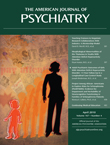Perhaps Freud's most significant contributions to psychology were his arguments concerning the importance of the unconscious mind in understanding conscious thought and behavior (
1). In his first topology of the mind, he proposed that the preconscious was a layer between conscious and unconscious thoughts and that a key factor in the operation of the unconscious was "repression" (
2). However, as Ellenberger pointed out, the discovery of the unconscious was shared with others, including the French psychiatrist Janet, as the idea arose in different places at about the same time (
1).
The recent discovery of a drawing of the mind sheds a new light on Charcot's contribution to the discovery of the unconscious. This particular drawing was found by one of us (C.B.) in Charcot's personal notes related to a lesson he gave on June 28, 1892, and kept in the Salpêtrière historical collection of the University Pierre and Marie Curie in Paris (collection reference: MA VIII 12, p. 2). Charcot's first ideas on unconscious processes were conceived in the early 1880s, when he performed in-depth studies on hysteria, understood its possible traumatic origin, and focused, in his Salpêtrière lessons, on the force of the idea and experimental paralysis (
3). About 10 years later, in 1892, the drawing was made at the time of 1) a substantial correspondence between Charcot and Janet on the case of Emma Dutemple, who suffered from hysterical amnesia, and 2) Charcot's lessons on personality disorders. In this lesson on June 28, Charcot explained that "the memories are on vacation in the unconscious where they are engraved; they do not get lost there.... It is as a latent ego but this ego is in a sense upper to the other one. It builds all which seemed lost."
In this scheme, the conscious ego (or "concrete ego," added Charcot) was the center of the mind. The unconscious stayed at the periphery of the conscious ego. As a consequence of a trauma or a nervous or affective shock, fixed ideas (
idées fixes), designated "I" in the figure, were produced and located in the unconscious, which Charcot compared to a "second ego in formation." He drew from "I" a vector he called
force de reviviscence that represented a force allowing recollection. The force located in the conscious ego was blocked by the fixed ideas. Is this vector the first description of Freud's repression, with its consequence of the return of repressed feelings or memories? This may be the case, as Charcot added that the unconscious, a second ego in formation, acted on the conscious ego. Under the drive of the fixed idea, the thoughts stayed at the outskirts, trapped in the unconscious, "the latent ego," unattainable, "repressed" (
3). Charcot's death in 1893 prevented his ideas and speculations on unconscious processes from being shared at that time. In particular, the study of the Charcot-Freud correspondence shows that Freud did not receive a significant portion of Charcot's idea about the unconscious (
3).
Acknowledgments
The authors thank Anne-Marie Vallin-Charcot, Veronique Leroux-Hugon, and Jean-Charles Pommerol.

